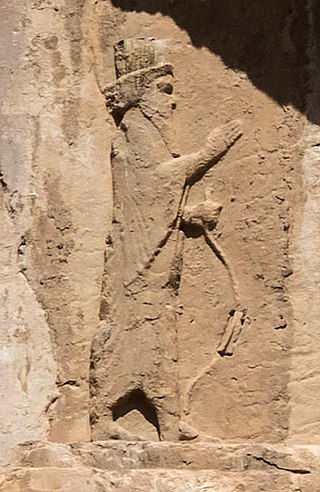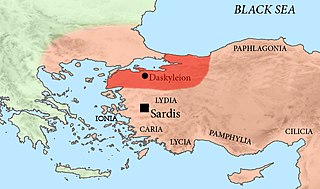
Xerxes I was a Persian ruler who served as the fourth King of Kings of the Achaemenid Empire, reigning from 486 BC until his assassination in 465 BC. He was the son of Darius the Great and Atossa, a daughter of Cyrus the Great. In Western history, Xerxes is best known for his invasion of Greece in 480 BC, which ended in Persian defeat.

Artaxerxes I was the fifth King of Kings of the Achaemenid Empire, from 465 to December 424 BC. He was the third son of Xerxes I.

Megabyzus was an Achaemenid Persian general, son of Zopyrus, satrap of Babylonia, and grandson of Megabyzus I, one of the seven conspirators who had put Darius I on the throne. His father was killed when the satrapy rebelled in 484 BCE, and Megabyzus led the forces that recaptured the city, after which the statue of the god Marduk was destroyed to prevent future revolts. Megabyzus subsequently took part in the Second Persian invasion of Greece. Herodotus claims that he refused to act on orders to pillage Delphi, but it is doubtful such orders were ever given.
Artabazos was a Persian general in the army of Xerxes I, and later satrap of Hellespontine Phrygia under the Achaemenid dynasty, founder of the Pharnacid dynasty of satraps. He was the son of Pharnaces, who was the younger brother of Hystaspes, father of Darius I. Artabazos was therefore a first cousin of the great Achaemenid ruler Darius I.

Khwarazm or Chorasmia is a large oasis region on the Amu Darya river delta in western Central Asia, bordered on the north by the (former) Aral Sea, on the east by the Kyzylkum Desert, on the south by the Karakum Desert, and on the west by the Ustyurt Plateau. It was the center of the Iranian Khwarezmian civilization, and a series of kingdoms such as the Afrighid dynasty and the Anushtegin dynasty, whose capitals were Kath, Gurganj and – from the 16th century on – Khiva. Today Khwarazm belongs partly to Uzbekistan and partly to Turkmenistan.
Mardonius was a leading Persian military commander during the Persian Wars with Greece in the early 5th century BC who died at the Battle of Plataea.

In the writings of the Ancient Greek chronicler Herodotus, the phrase earth and water is used to represent the demand by the Persian Empire of formal tribute from the cities or people who surrendered to them.

The Dahae, also known as the Daae, Dahas or Dahaeans were an ancient Eastern Iranian nomadic tribal confederation, who inhabited the steppes of Central Asia.

Parthia is a historical region located in northeastern Greater Iran. It was conquered and subjugated by the empire of the Medes during the 7th century BC, was incorporated into the subsequent Achaemenid Empire under Cyrus the Great in the 6th century BC, and formed part of the Hellenistic Seleucid Empire after the 4th-century BC conquests of Alexander the Great. The region later served as the political and cultural base of the Eastern Iranian Parni people and Arsacid dynasty, rulers of the Parthian Empire. The Sasanian Empire, the last state of pre-Islamic Iran, also held the region and maintained the seven Parthian clans as part of their feudal aristocracy.

The second Persian invasion of Greece occurred during the Greco-Persian Wars, as King Xerxes I of Persia sought to conquer all of Greece. The invasion was a direct, if delayed, response to the defeat of the first Persian invasion of Greece at the Battle of Marathon, which ended Darius I's attempts to subjugate Greece. After Darius's death, his son Xerxes spent several years planning for the second invasion, mustering an enormous army and navy. The Athenians and Spartans led the Greek resistance. About a tenth of the Greek city-states joined the 'Allied' effort; most remained neutral or submitted to Xerxes.

The Pharnacid dynasty was a Persian dynasty that ruled the satrapy of Hellespontine Phrygia under the Achaemenid Dynasty from the 5th until the 4th century BCE. It was founded by Artabazus, son of satrap Pharnaces I, son of Arsames. They were directly related to the Achaemenid dynasty itself. The last member of the dynasty was Pharnabazus III.

The Achaemenid Empire or Achaemenian Empire was the ancient Iranian empire founded by Cyrus the Great in 550 BC, known also as the First Persian Empire. Based in Western Asia, it was the largest empire the world had ever seen at its time, spanning a total of 5.5 million square kilometres from the Balkans and Egypt in the west to Central Asia and the Indus Valley in the east.

The Achaemenid conquest of the Indus Valley occurred from the 6th to 4th centuries BCE, and saw the Persian Achaemenid Empire take control of regions in the northwestern Indian subcontinent that predominantly comprise the territory of modern-day Pakistan. The first of two main invasions was conducted around 535 BCE by the empire's founder, Cyrus the Great, who annexed the regions west of the Indus River that formed the eastern border of the Achaemenid Empire. Following Cyrus' death, Darius the Great established his dynasty and began to re-conquer former provinces and further expand the empire. Around 518 BCE, Persian armies under Darius crossed the Himalayas into India to initiate a second period of conquest by annexing regions up to the Jhelum River in Punjab.
Hydarnes II, also known as Hydarnes the Younger was a Persian commander of the Achaemenid Empire in the 5th century BC. He was the son of Hydarnes, satrap of the Persian empire and one of the seven conspirators against Gaumata.

Achaemenid Macedonia refers to the period in which the ancient Greek Kingdom of Macedonia was under the sway of the Achaemenid Persians. In 512/511 BC, the Persian general Megabyzus forced the Macedonian king Amyntas I to make his kingdom a vassal of the Achaemenids. In 492 BC, following the Ionian Revolt, the Persian general Mardonius firmly re-tightened the Persian grip in the Balkans, making Macedon a fully subordinate kingdom within the Achaemenid domains and part of its administrative system. Macedonia served the Achaemenid Empire during the Greco-Persian Wars in their invasion of mainland Greece. They regained independence following the defeat and withdrawal of the Achaemenid Empire in 479 BC.

Pharnaces Ι was a son of Arsames. He was a younger brother of Hystaspes, and therefore an uncle of Achaemenid Emperor Darius I, son of Hystaspes. He was the founder of the Pharnacid dynasty that ruled over Hellespontine Phrygia.

Artabanus was a son of Hystaspes, and therefore brother of Darius I as well as uncle of Xerxes I.

Bubares was a Persian nobleman and engineer in the service of the Achaemenid Empire of the 5th century BC. He was one of the sons of Megabazus, and a second-degree cousin of Xerxes I.

Gandāra, or Gadāra in Achaemenid inscriptions was one of the easternmost provinces of the Achaemenid Empire in South Asia, following the Achaemenid invasion of the Indus Valley. It appears in various Achaemenid inscriptions such as the Behistun Inscription, or the DNa inscription of Darius the Great.
Azanes was a Sogdian general. He led a contingent of troops in the Achaemenid army of Xerxes I during the Second Persian invasion of Greece in 480 BC.















